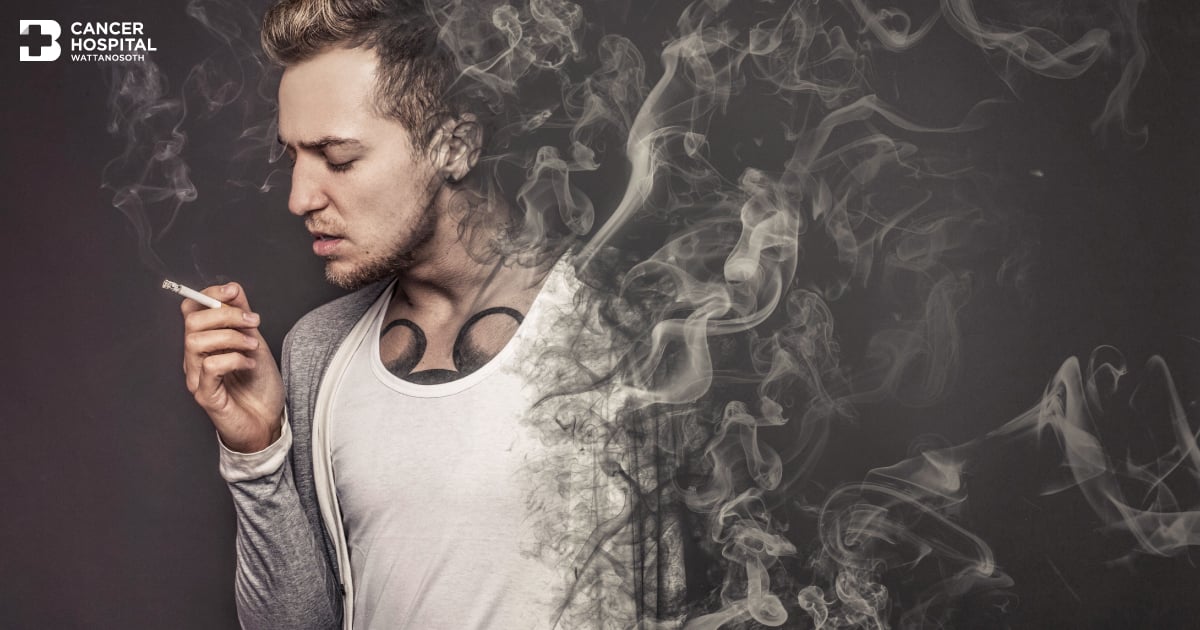
Lung Cancer
Information about Lung Cancer
Statistics from the World Health Organization or WHO show that lung cancer is the number one cause of death in all cancers. In 2012, there were 1,590,000 deaths recorded worldwide. In Thailand in 2008 there were 8,403 people diagnosed with lung cancer. Lung cancer is more common in men than women; it is also more prevalent in the elderly.

Causes of Lung Cancer
Lung Cancer will involve a tumor in the lung which grows rapidly and can spread to adjacent and surrounding organs. It occurs as a result of cell abnormality that is uncontrollable. They are typically caused by external factors such carcinogens found in cigarettes and pollutants from the environment which causes changes to occur in our cells. Internal factors that lead to lung cancer may include genetics and deterioration of cells causing inability to repair itself.
External factors can be prevented, risk factors of lung cancer include inhalation of smoke, this can be either directly or indirectly (second-hand smoke). Furthermore, research has shown that carcinogens could come from the environment or working conditions that contain Radon and Asbestos, for example.
Symptoms and Diagnosis of Lung Cancer
Symptoms may include chronic cough and coughing up blood. In cases where the cancer has spread, other symptoms will depend on the organ it has spread to. Different organs which have been affected will cause varying symptoms such as pain radiating down the arm, ptosis, sweating irregularities, swollen face, swollen neck, and inability to lie down. Other symptoms may be associated with headaches and nausea, as well as back pain, incontinence, weakness in arms and legs, finding a lump in the collarbone area, or rapid weight loss.
Diagnosis of lung cancer will begin with examination of medical history and a health check-up. Further tests will be conducted such as lung X-ray and MRI scan. Confirmation of the existence of lung cancer can be obtained by examining the results of a Pathology tests such as a biopsy. Obtaining a cell sample can be achieved by endoscope or lung need biopsy. Apart from providing confirmation, pathology can help to determine whether the cancer is Small Cell Lung Cancer or Non-Small Cell Lung Cancer.
Once initial diagnosis is complete, further tests will be conducted to determine the stage and distribution of the cancer. This can be achieved through a bone scan and/or PET/CT scan. Insight gained will be pivotal in decision on treatment method.

Treatment of Lung Cancer
Treatment of lung cancer will depend on the type which may be either Small cell Lung Cancer or Non-Small cell Lung Cancer.
Small-cell lung cancer has a tendency to spread rapidly and is responsive to Chemotherapy and Radiotherapy. The main treatment choice is Chemotherapy with the goal of destroying cancer cells at the beginning to prevent them from spreading to other organs. It is supported by radiotherapy to maximize efficiency of controlling or isolating the cancer. When both methods are combined simultaneously and intermittently it is referred to as Chemoradiotherapy. Treatment will depend on the stage of cancer, patient’s physical condition, doctor’s opinion, and patient consent.
Treatment of non-small cell cancers, which is a disease that does not spread in its early stages or which spreads slowly, is mainly surgical. However consideration may be given to chemotherapy, targeted therapy, and radiotherapy, as required to maximize chances of effective treatment. In cases where the cancer has spread, is at risk of spreading or has a high chance of recurring treatment plan may include chemoradiotherapy, as well as Targeted Therapy as seen fit by your oncologist. Ultimately, treatment will depend on the stage of cancer, patient’s physical condition, doctor’s opinion, and patient consent.

Chemotherapy (often abbreviated to chemo and sometimes CTX or CTx) is a category of cancer treatment that uses chemical substances, especially one or more anti-cancer drugs (chemotherapeutic agents) that are given as part of a standardized chemotherapy regimen. Radiotherapy refers to the use of radiation rays to destroy cancer cells in a designated area.
In cases where the cancer has grown and/or has spread to other organs and the patient is in a poor physical condition, there are higher risks that treatment will cause unwanted side effects. The treatment we offer will focus on providing a good quality of life for the patient, treatment decision will be based on the stage of cancer, symptoms, and needs of the patient and his/her relatives (palliative care).
Services in Lung cancer treatment will be provided by a team of oncologists, nurses, and other multidisciplinary medical personnel. We offer multi-dimensional care that takes into consideration physical, emotional, and social needs of the patient and his/her relatives.
Wattanosoth Hospital is designed to offer comprehensive care for cancer patients, from the screening and early detection program, treatment with hi-end technology, a multidisciplinary medical team, and a palliative care team.